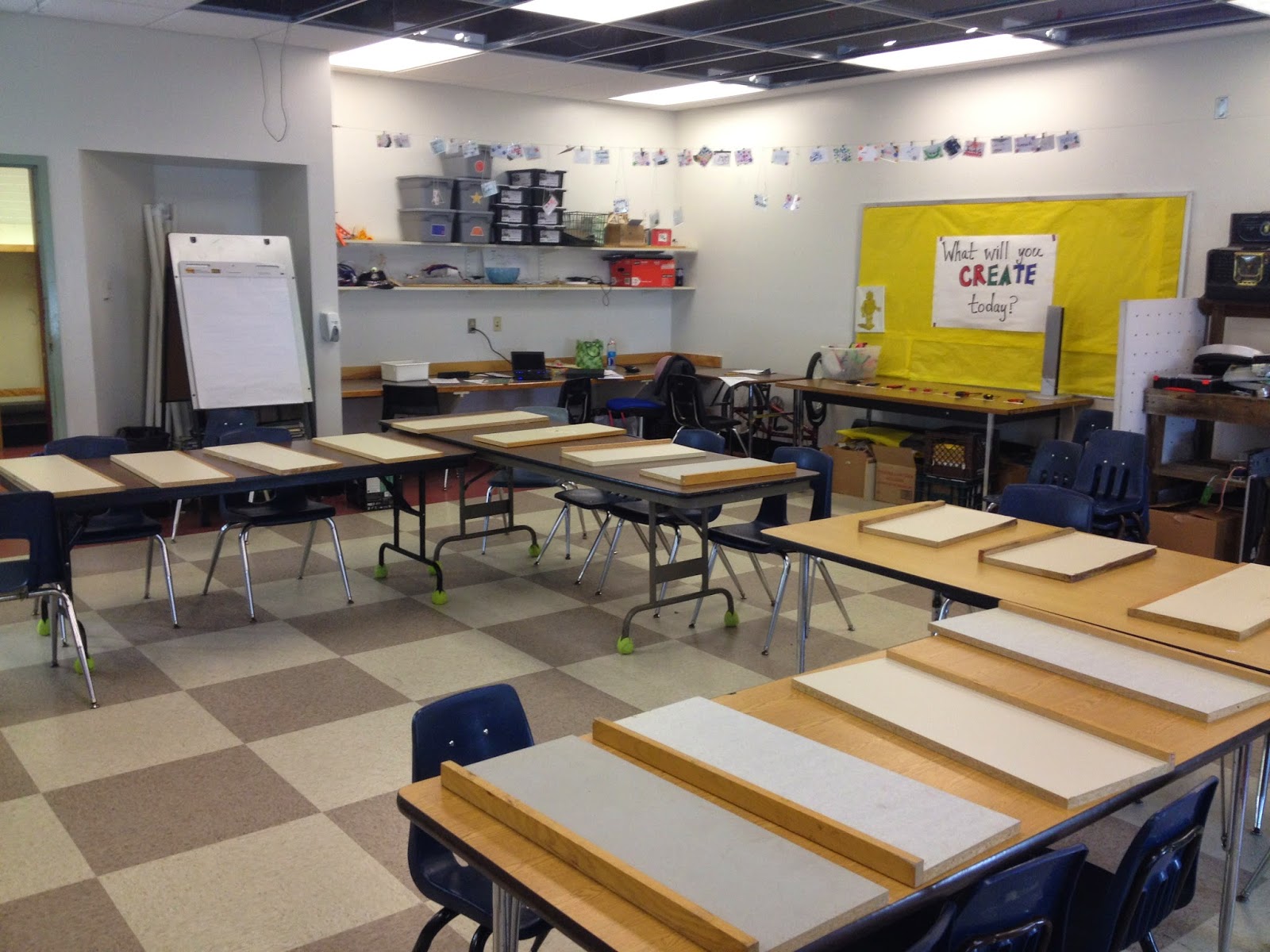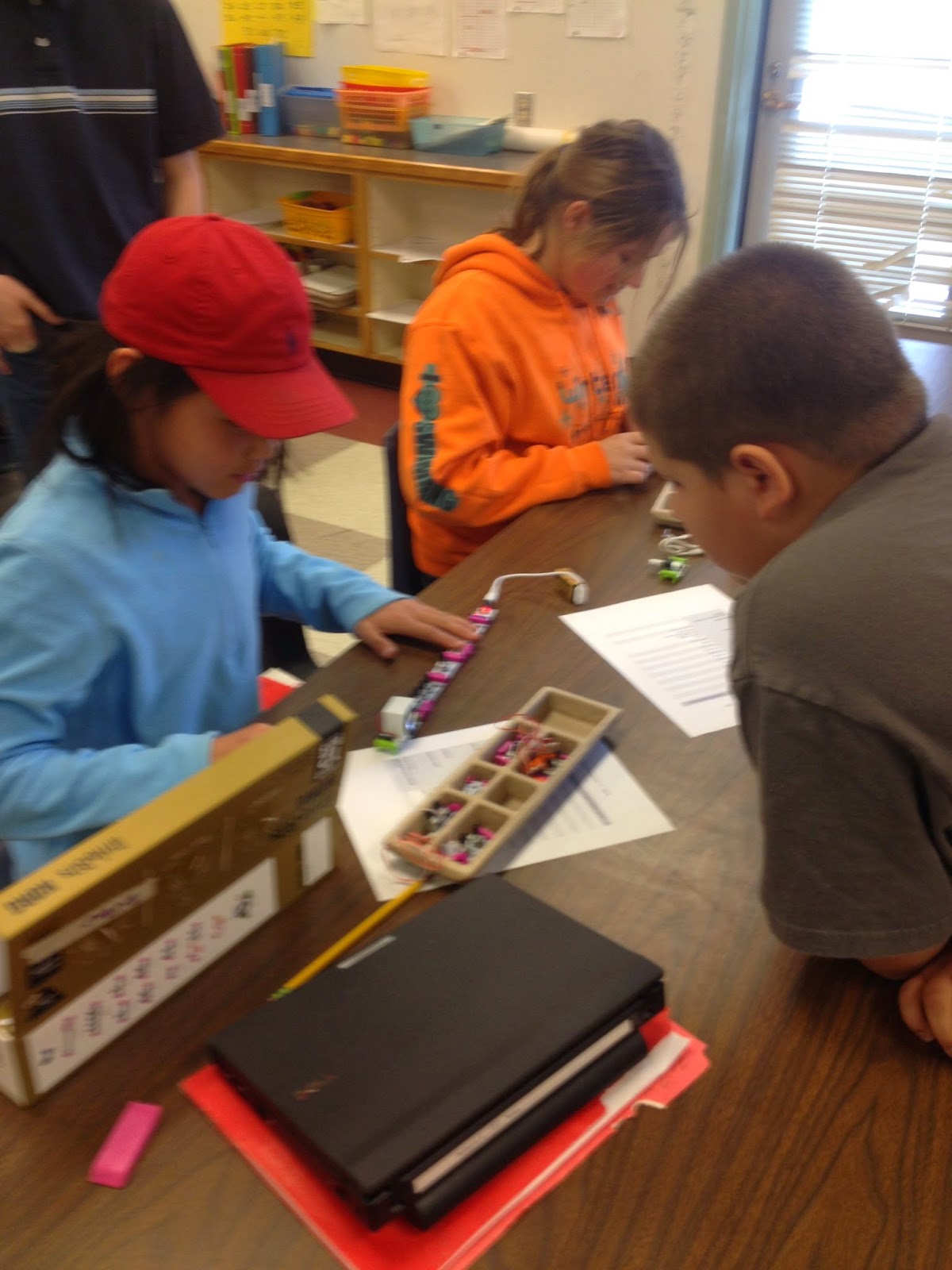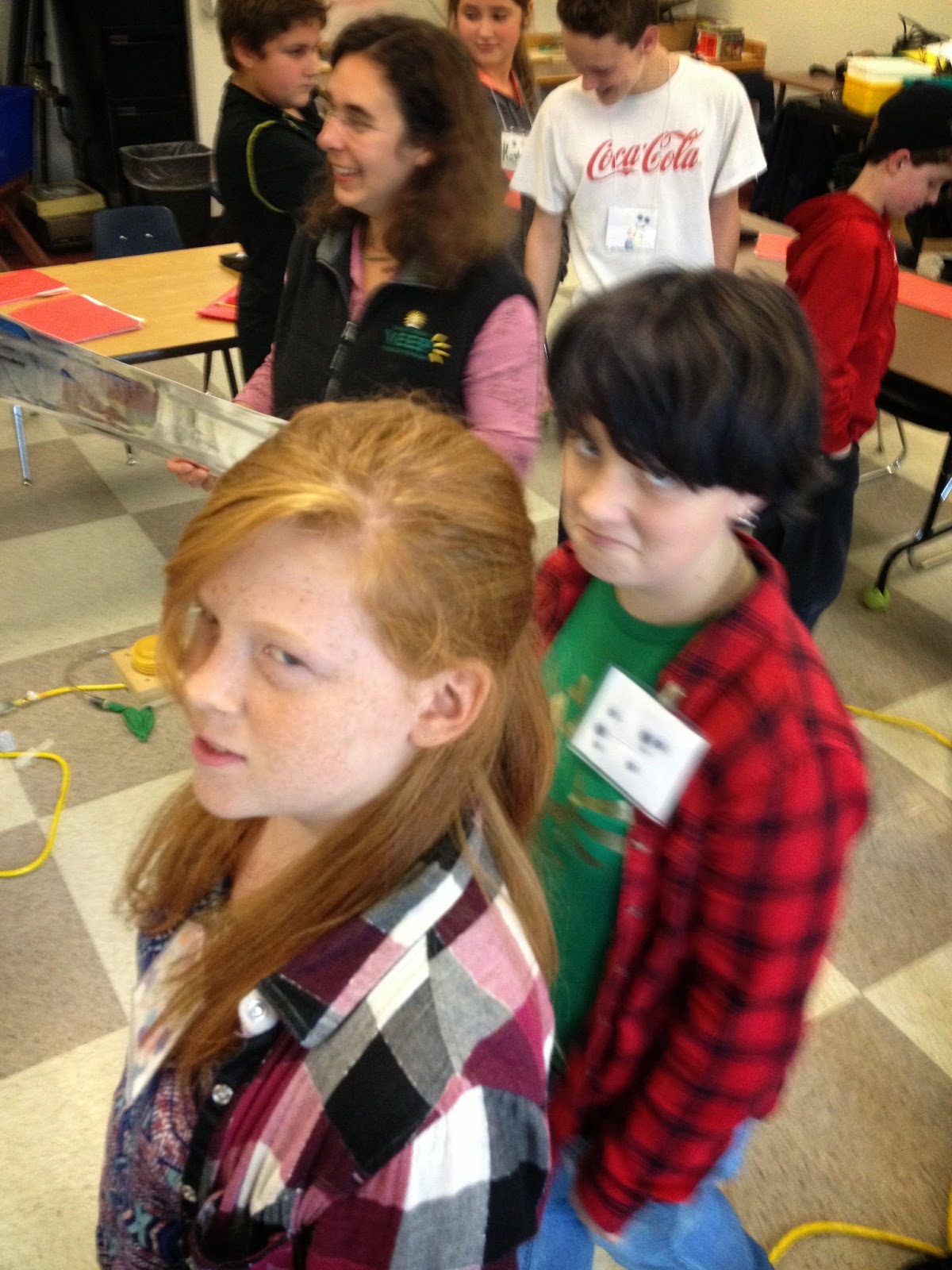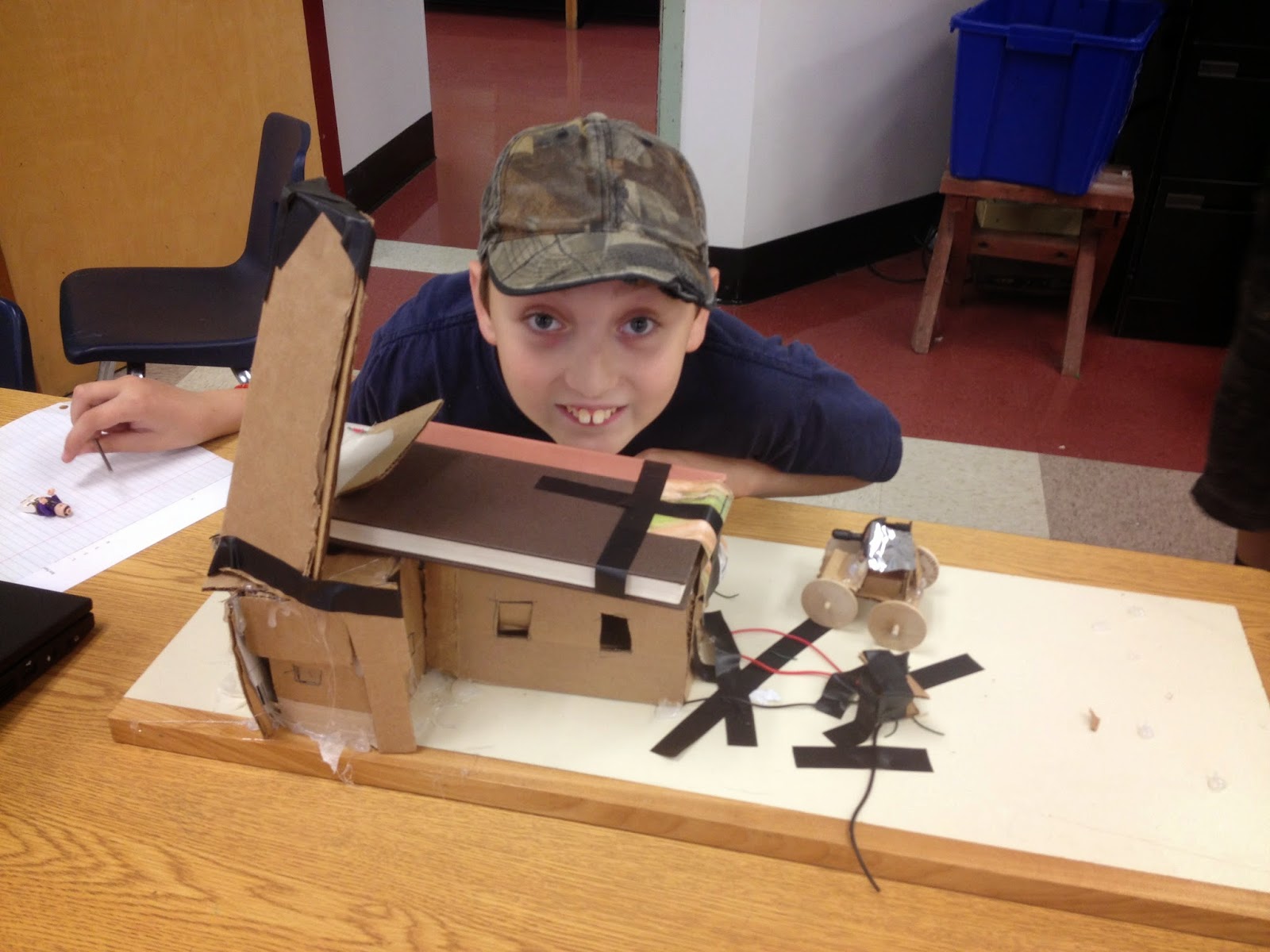Moretown 4th grade creators
Work with the EV3 Robots
Moretown 4th grade Creators
Present Models to Classmates
4th Grade students presented their "works in progress" engineering projects to their classmates today. Students needed to answer the following questions as part of their presentation:
1. Where am I on the design cycle - and why do I think I am there.
2. Explain what I am working on - what is the project now and what will it be
3. What were some of the challenges I faced making it
4. What were some of the celebrations I have had working on it.
Next Generation Science Standard Met:
3.5 Define a simple design problem reflecting a need to a want that includes specific criteria for success and constraints on materials, time or cost
Most of our creators presented today. A series of pictures of the past week of project development are posted below:
March 2015
4th Graders begin their STE@M experience
Students began their STE@M with an introduction to the room, safety habits, important classroom routines and a team/design experience. Students will focus their attention on the design process generally utilized by many professional creators. The following design flow is one of the basic tenants found within the Next Generation Science Standards.
Students participated in a team building design challenge for their first project. Some teams excelled, others found themselves struggling to overcome some of the obstacle within the challenge. The goals was to utilize materials to raise a marshmallow as high as possible from the STE@M lab tabletops. Here are some pics from our adventure.
Over the next week, students will utilize the Design cycle as they create models of their ideas about what students wanted to create. The following weeks will be devoted to coding, building and programming our EV3 robots in class.
Next Generation Science Standard Met: Model development
We are very excited to work with our 4th grade creators!
_________________________________________________
February 2015
End of the 5th grade STE@M - Great Class -
Students ended their time with the STE@M class with our VEEP (Vermont Energy Education Program) and their curriculum on Energy and Conservation. Students worked in small groups to conduct experiments on wind and solar panel arrays and their ability to generate electricity. Students ended their class today with a discussion and review on energy generators, safety and efficiency.
Students begin work with e-textiles as we transition from robotics to working with electricity, circuits and energy. Students will create bookmarks using conductive thread, batteries and circuits. We will continue our exploration as well work with a variety of tools, activities and hands on opportunities. Pictures coming.......
__________________________________________________________
The coming of the
ROBOTS
January 2015
Grade 5 students have been investigating the programming of Lego Mind Storm Robots within small teams during their STE@M class time.
January 16, 2015
Grade 5 students continue to work through a checklist of skills that will help students understand coding/programming their robots. Challenges include following specific directions in a linear/sequential order
– Use digital media and environments to communicate and work collaboratively
Gingerbread house project completed!
December 2014!
Here are some updated pictures - it is difficult to keep to their original design of their houses - but for the most part they are doing well.










5th Grade STE@M
December 2014
5th Grade
STE@M Begins 11/24/14
Grade 5 students have been working in teams to design and test the strength of bridge building. Bridges were tested last Friday. Student designers gave and received feedback about what worked, what did not work and how they could make a better bridge next time. See photos on our website twitter feed.
___________________________________________________
6th Grade
Final Days of STE@M





Class Updates are listed by most recent first
October 27 - 31
STE@M students explored green screen media production this week. We experienced some initial roadblocks and difficulties utilizing our school's ipads, however we persevered and began to develop commercials for supporting our STE@M project at The Moretown School. As a requirement for the project student must develop a storyboard of what they want to produce, select creative backgrounds and interesting/engaging storylines to produce as their final green scene project. See pictures below.
October 20 - 24
STE@M students learned about energy from our VEEP partner educator Erin Maloy. We started the week with a brief introduction to world of energy by exploring Squishy Circuits. The essential question of What is Energy was discussed and our week of energy discovery began.
Beginning October 27 our focus will on creating media projects about our class using green screen technologies.. http://youtu.be/QlH3h19ablI
Learning about electrons, neutrons and protons- in motion...
Examining how a steam engine makes power..

Magnets create electricity..
October 6 - 17
Work with the EV3 Robots
For the past three weeks our 4th grade STE@M creators utilized basic coding skills to program LEGO EV3 robots to perform basic movement and sensing tasks. Student began this unit by building their robots, naming them (one name that stands out is "French Fry"), and programming them according to a task list given to each group. The complexities of getting started with this machine was challenging due to complex building and basic programming skills needed, however, by the third week groups were easily completing tasks and challenging themselves to reach beyond our unit goals. One group of creators was challenged to "predict" the number of rotations (coding language - ask your creator what this means) needed to get their EV3 from the STE@M classroom to the library. We are sad to see them go as today, April 17th is our last day with the EV3's. Fare thee well EV3's.
Classroom standards modeled and assessed in this unit correspond the Next Generation Science Standard 3.5 Engineering Design "Plan and carry out fair tests in which variables are controlled and failure points are considered to identify aspects of a model or prototype that can be improved.
Moretown 4th grade Creators
Present Models to Classmates
4th Grade students presented their "works in progress" engineering projects to their classmates today. Students needed to answer the following questions as part of their presentation:
1. Where am I on the design cycle - and why do I think I am there.
2. Explain what I am working on - what is the project now and what will it be
3. What were some of the challenges I faced making it
4. What were some of the celebrations I have had working on it.
Next Generation Science Standard Met:
3.5 Define a simple design problem reflecting a need to a want that includes specific criteria for success and constraints on materials, time or cost
Most of our creators presented today. A series of pictures of the past week of project development are posted below:
March 2015
4th Graders begin their STE@M experience
Students began their STE@M with an introduction to the room, safety habits, important classroom routines and a team/design experience. Students will focus their attention on the design process generally utilized by many professional creators. The following design flow is one of the basic tenants found within the Next Generation Science Standards.
Students participated in a team building design challenge for their first project. Some teams excelled, others found themselves struggling to overcome some of the obstacle within the challenge. The goals was to utilize materials to raise a marshmallow as high as possible from the STE@M lab tabletops. Here are some pics from our adventure.
Over the next week, students will utilize the Design cycle as they create models of their ideas about what students wanted to create. The following weeks will be devoted to coding, building and programming our EV3 robots in class.
Next Generation Science Standard Met: Model development
We are very excited to work with our 4th grade creators!
_________________________________________________
February 2015
End of the 5th grade STE@M - Great Class -
Students ended their time with the STE@M class with our VEEP (Vermont Energy Education Program) and their curriculum on Energy and Conservation. Students worked in small groups to conduct experiments on wind and solar panel arrays and their ability to generate electricity. Students ended their class today with a discussion and review on energy generators, safety and efficiency.
Students begin work with e-textiles as we transition from robotics to working with electricity, circuits and energy. Students will create bookmarks using conductive thread, batteries and circuits. We will continue our exploration as well work with a variety of tools, activities and hands on opportunities. Pictures coming.......
__________________________________________________________
The coming of the
ROBOTS
January 2015
Grade 5 students have been investigating the programming of Lego Mind Storm Robots within small teams during their STE@M class time.
January 16, 2015
Grade 5 students continue to work through a checklist of skills that will help students understand coding/programming their robots. Challenges include following specific directions in a linear/sequential order
Key Learning Target for GRADE 5 - Mind Storm Projects
– Learn and use engineering design process skills
– Understand and use mathematical skills and concepts, such as proportions and ratios, graphing data and multi-digit computation
– Apply knowledge of science concepts, such as speed and power, motion and stability, and forces and interactions
– Understand cross-cutting concepts, such as systems, patterns, structure and function, and logical thinking
– Understand the core concepts of technology
– Understand the role of troubleshooting, invention and innovation, and experimentation in problem solving
– Plan and manage activities to develop a solution or complete a project
– Demonstrate creative thinking and construct knowledge using technology
Gingerbread house project completed!
December 2014!
Here are some updated pictures - it is difficult to keep to their original design of their houses - but for the most part they are doing well.
 |
| Proud Builder! |










5th Grade STE@M
December 2014
Grade 5 students explored the basics of a professional grade design software package- Sketch-Up Professional. Students have been engaged in exploring the use of the application as it pertains to deigning basic shapes, orientations of objects and making adjustments to existing objects. Students have been given a task to design and develop a gingerbread house design that students will use to create their own "real" gingerbread houses in class. Most students will work a individual designers, however, there may be some teams that work together for their final project. Pictures to follow....


 |
| Examples of a model project made with pretzels.. |
5th Grade
STE@M Begins 11/24/14
Grade 5 students have been working in teams to design and test the strength of bridge building. Bridges were tested last Friday. Student designers gave and received feedback about what worked, what did not work and how they could make a better bridge next time. See photos on our website twitter feed.
___________________________________________________
6th Grade
Final Days of STE@M
Grade 6 students have completed their journey through their12 week STE@M program. Today November 21st marks the end of our STE@M journey that was captured on this blog. During their final week 6th grade students had the opportunity to participate in a wide variety of activities that allowed them to build a variety of circuits in the classroom. We utilized Makey/Makey http://youtu.be/rfQqh7iCcOU kits, Little Bit kits http://youtu.be/vgsOCDvI7zA?list=UU_2hEbur8-gPYMYl5Z5_48A, Soldering Kits, more of the green screen equipment, and an attempt at utilizing Arduinos http://youtu.be/vgsOCDvI7zA?list=UU_2hEbur8-gPYMYl5Z5_48A (unfortunately our units did not function due to a driver conflict with the program- we will work on this for the next class) Students ended the trimester by developing an argument paragraph that will either support or not support the idea that STE@M is a part of the school curriculum.
Our 6th grade class completed approximately half the the proposed units of study outlined in our initial course guide. We have learned that students appreciate diving deeper into each unit rather than experiencing a brief introduction to the named units. We hope our students have gained an appreciation of the world of design and making and that they have been inspired to keep creating!
 |
| Little Bits Exploration |
 |
| Makey Makey kit exploration |
 |
| Soldering Station |

 |
| Green Screen Projects on Super Heros |




Class Updates are listed by most recent first
October 27 - 31
STE@M students explored green screen media production this week. We experienced some initial roadblocks and difficulties utilizing our school's ipads, however we persevered and began to develop commercials for supporting our STE@M project at The Moretown School. As a requirement for the project student must develop a storyboard of what they want to produce, select creative backgrounds and interesting/engaging storylines to produce as their final green scene project. See pictures below.
 |
| Liam practicing his line |
 |
| working on sound clips - not so easy of a task |
 |
| Delana's team had an excellent story board! Great work |
 |
| Liam's project - working on lighting |
 |
| Alanya searching for backgrounds |
 |
| working on interesting backgrounds |
 |
| Kaylee - the producer |
October 20 - 24
STE@M students learned about energy from our VEEP partner educator Erin Maloy. We started the week with a brief introduction to world of energy by exploring Squishy Circuits. The essential question of What is Energy was discussed and our week of energy discovery began.
Beginning October 27 our focus will on creating media projects about our class using green screen technologies.. http://youtu.be/QlH3h19ablI
Examining how a steam engine makes power..

October 6 - 17
Completed 3D designed and built model homes
STE@M students completed their house build projects today. Most students went beyond building a typical model - instead created amazing homes with a wide variety of add-ons which include complex circuits, fans, solar arrays etc. Really impressive!! Students will complete this project by receiving and giving feedback to their classmates on Monday. Once we complete this final portion of the unit - we will transition to our next unit of study - Lights/Camera/Action! We will begin this study by utilizing Squishy Circuits http://youtu.be/zuctJfIhNyI as models for use with green screne technologies.
Completed Model Homes
6th Grade STE@M
Building Principles
October 6 - October 17
STE@M students continued to learn about energy efficiencies as it relates to home design and improvements. Students designed homes utilizing a professional grade 3D design software (Sketch up Pro version 2014). After the design was approved (a requirement was to include 3 energy efficiencies in their model homes - ask students to tell you a couple of them at home) students created their homes with a variety of reusable supplies (you might see some books used in a different way) Pictures of these model homes are included below. We will finish their build project and presentations by the October 17.
6th Grade STE@M
Building Principles
Students started this Unit with an introduction to house design and energy conservation by our VEEP partner Erin Maloy. Erin used four model homes (built of cardboard and tape) to demonstrate the differences between different house styles, insulation types and air flow as it relates to energy conservation and use. Students have started to utilize Sketchup Pro 3D design software to create their own home with energy conservation elements as part of their requirements. Once the design process is complete students will build their own homes with a wide variety of materials to demonstrate how they created an energy efficient home. Students will continue this work through the beginning of next week. We hope to transition to creating media projects by the end of next week.
As always let us know if you have any questions.
6th Grade STE@M
Learning the Tools of the Trade
September 22- 26
Student started their week reviewing their Animoto projects with their peers. We will post a few of these on this blog early next week.
On Wednesday, students met Erin Maloy, our VEEP educator and community liaison regarding our school's involvement with determining how to improve our school's energy footprint and associated costs. We were introduced to three tools used by field technicians who conduct energy audits for homes and businesses.
On Thursday, students were introduced to the most important tool, our mind. We explored the use of the design cycle as a process to be utilized when creating crafts or projects. To explore this process students worked in teams to design, build and test "edible cars". We had one team find success as others found some challenges to build a car that actually works. We will take some time next week to discuss and reflect upon our how things went - and what we can improve.
On Monday, September 29, our VEEP partners will be back to help introduce our next unit "Building Principles" examining energy use, conservation and efficiency opportunities for homes/buildings.
6th Grade STE@M INSPIRE UNIT #1
Continuation Sept 22/23
6th Grade STE@M UNIT #2
Learning the Tools of the Trade
September 24 - 26
This past week students continued researching as well as creating an Animoto project on their inventors/engineers. Students will complete their Animoto projects today with the expectation that student presentations will begin on Monday, September 22. The rubric listed below is what students will be assessed on (see below) The project will culminate by completing our Project Protocol Forms so that they will capture their learning for review by classmates and the instructors. (as in real world situations, documentation and review/reflection is an essential part in any engineering project)
Starting on September 24, our partner organization (Vermont Energy Education Program) will present to our school a variety of tools that environmental engineers utilize while conducting energy evaluations in Vermont homes and businesses. We will focus on the use of these science tools as well as other classroom tools that we use for the remainder of the 6th Grade STE@M class. The 6th grade class will take on a real world problem of investigating the rise of the Moretown School's energy bill (much higher than our neighbor schools) over the past three years as well as investigating options to reverse this trend.
This is an example of one tool that will be introduced to the 6th graders on Wednesday:
As always contact me with questions or concerns.
6th Grade STE@M INSPIRE UNIT #1
September 9 - September 12
This past week our 6th grade STE@M students completed both the jitterbot project as well as their project prototype/feedback forms.
***Something to ask at home***
Robert Goddard was selected by a student for his research project. Ask your student what inventor/engineer they selected????
Robert Goddard was selected by a student for his research project. Ask your student what inventor/engineer they selected????
Students selected an engineers and/or inventors to complete a research project on by the end of the next week (9/19/14). The expectations of the project support the common core standards for the 6th grade around inquiry and presentation. Students will conduct research utilizing the web, readings and world book online.
Students will need to list their sources of information, complete a research guide and design a http://animoto.com/ project for their final project. An assessment rubric for this project will be passed out early next week as students begin to put their projects together. Projects will be presented on September 11 and 12.
Next Unit - Tools of the Trade (The Vermont Energy Education Program will partner with us for this and the subsequent unit)
456 STE@M INTRODUCTION
August 26 - September 9
We are excited to let everyone know that the Jitter-bots are in the last phase of production. Students have been working on designing and constructing their bots with the help of their classmates and are ready for their design purpose. The bots are a part of the introductory unit to the STE@M curriculum that each 4, 5, 6 student will be a part of this year. Due to some scheduling issues, our partners with the STE@M curriculum, Vermont Energy Education Program was unable to attend our class today - but will be back next week.
The jitter-bots are project based around the Next Generation Science Standards that involve use of science (in this case electrical circuits) to power a machine to make a piece of visual art. Students followed our goal-setting and prototype forms to help guide their thinking about design, feedback, and re-design as they progressed.
There are the goal setting and assessment forms...
Questions about the project
Students working on their projects
Next week we will finish our Jitter-bot project early then begin our 12 week STE@M program with the 6th graders. Our first task to explore/discover both men and woman who were/are the inventors and creators of the machines that have influenced our society. This is the beginning of our Inspire unit of study.
Please let me know if you have any questions or comments.
dpierson@wwsu.org























































































































































































No comments:
Post a Comment